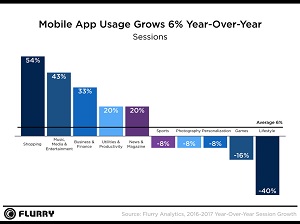News
Report: Mobile App Growth Slows, Phablet Form Factor Rises
- By David Ramel
- January 10, 2018
"2017 was the year that mobile app innovation and growth was disrupted," said mobile analytics company Flurry in its year-end report, which also noted the rise of the phablet form factor at the expense of medium-sized phones.
In reporting slower growth in app usage, Flurry was referring to the number of "sessions" it tracks, which are started when a user opens up an app. Session year-over-year growth from 2016 to 2017 was just 6 percent, compared to the 11 percent growth tracked from 2015 to 2016.
Some categories of app usage showed much higher growth, however, especially Shopping, which grew 54 percent. At the other end of the spectrum, the Lifestyle category (a catchall category for both the Google Play and Apple App stores) fell 40 percent.
Flurry, which says it's now tracking more than 1 million apps across 2.6 billion devices with its software, also noted a change in form factor distribution, with phablets advancing and medium-sized phones decreasing.
 [Click on image for larger view.]
App Category Winners and Losers (source: Flurry)
[Click on image for larger view.]
App Category Winners and Losers (source: Flurry)
"Understanding form factor adoption is critical for both app developers and marketers, as we know that usage differs between devices," the company said in a post today. "2017 proved that there is no end in sight for phablet growth -- they represent a staggering 55 percent of active devices. As medium phone users trade in their devices, it is clear that they're opting for phablet devices, as 9 percent of the phablet growth came from medium phone adoption decline."
In the Apple-vs-Android war, Flurry noted that Apple, accounting for 34 percent of all active devices, dominated individual market share even though the fragmented Android camp (led by Samsung at 28 percent) included some two-thirds of all active devices last year.
"Although session growth may have stalled, it has never been more apparent that mobile apps and smartphones have cemented their roles in users' lives," Flurry concluded. "While users, marketers and the tech industry drive towards what's next, developers have an incredibly captive audience and a platform to engage them."
About the Author
David Ramel is an editor and writer at Converge 360.